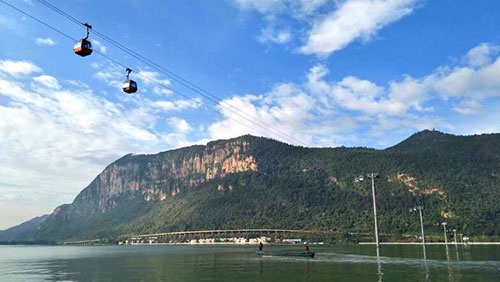AI6126代做、Python設計程序代寫
時間:2024-04-12 來源: 作者: 我要糾錯
2023-S2 AI6126 Project 2
Blind Face Super-Resolution
Project 2 Specification (Version 1.0. Last update on 22 March 2024)
Important Dates
Issued: 22 March 2024
Release of test set: 19 April 2023 12:00 AM SGT
Due: 26 April 2023 11:59 PM SGT
Group Policy
This is an individual project
Late Submission Policy
Late submissions will be penalized (each day at 5% up to 3 days)
Challenge Description
Figure 1. Illustration of blind face restoration
The goal of this mini-challenge is to generate high-quality (HQ) face images from the
corrupted low-quality (LQ) ones (see Figure 1) [1]. The data for this task comes from
the FFHQ. For this challenge, we provide a mini dataset, which consists of 5000 HQ
images for training and 400 LQ-HQ image pairs for validation. Note that we do not
provide the LQ images in the training set. During the training, you need to generate
the corresponding LQ images on the fly by corrupting HQ images using the random
second-order degradation pipeline [1] (see Figure 2). This pipeline contains 4 types
of degradations: Gaussian blur, Downsampling, Noise, and Compression. We will
give the code of each degradation function as well as an example of the degradation
config for your reference.
Figure 2. Illustration of second-order degradation pipeline during training
During validation and testing, algorithms will generate an HQ image for each LQ face
image. The quality of the output will be evaluated based on the PSNR metric
between the output and HQ images (HQ images of the test set will not be released).
Assessment Criteria
In this challenge, we will evaluate your results quantitatively for scoring.
Quantitative evaluation:
We will evaluate and rank the performance of your network model on our given 400
synthetic testing LQ face images based on the PSNR.
The higher the rank of your solution, the higher the score you will receive. In general,
scores will be awarded based on the Table below.
Percentile
in ranking
≤ 5% ≤ 15% ≤ 30% ≤ 50% ≤ 75% ≤ 100% *
Scores 20 18 16 14 12 10 0
Notes:
● We will award bonus marks (up to 2 marks) if the solution is interesting or
novel.
● To obtain more natural HQ face images, we also encourage students to
attempt to use a discriminator loss with a GAN during the training. Note that
discriminator loss will lower the PSNR score but make the results look more
natural. Thus, you need to carefully adjust the GAN weight to find a tradeoff
between PSNR and perceptual quality. You may earn bonus marks (up to 2
marks) if you achieve outstanding results on the 6 real-world LQ images,
consisting of two slightly blurry, two moderately blurry, and two extremely
blurry test images. (The real-world test images will be released with the 400
test set) [optional]
● Marks will be deducted if the submitted files are not complete, e.g., important
parts of your core codes are missing or you do not submit a short report.
● TAs will answer questions about project specifications or ambiguities. For
questions related to code installation, implementation, and program bugs, TAs
will only provide simple hints and pointers for you.
Requirements
● Download the dataset, baseline configuration file, and evaluation script: here
● Train your network using our provided training set.
● Tune the hyper-parameters using our provided validation set.
● Your model should contain fewer than 2,276,356 trainable parameters, which
is 150% of the trainable parameters in SRResNet [4] (your baseline network).
You can use
● sum(p.numel() for p in model.parameters())
to compute the number of parameters in your network. The number of
parameters is only applicable to the generator if you use a GAN.
● The test set will be available one week before the deadline (this is a common
practice of major computer vision challenges).
● No external data and pre-trained models are allowed in this mini
challenge. You are only allowed to train your models from scratch using the
5000 image pairs in our given training set.
Submission Guidelines
Submitting Results on CodaLab
We will host the challenge on CodaLab. You need to submit your results to CodaLab.
Please follow the following guidelines to ensure your results are successfully
recorded.
● The CodaLab competition link:
https://codalab.lisn.upsaclay.fr/competitions/18233?secret_key
=6b842a59-9e76-47b1-8f56-283c5cb4c82b
● Register a CodaLab account with your NTU email.
● [Important] After your registration, please fill in the username in the Google
Form: https://forms.gle/ut764if5zoaT753H7
● Submit output face images from your model on the 400 test images as a zip
file. Put the results in a subfolder and use the same file name as the original
test images. (e.g., if the input image is named as 00001.png, your result
should also be named as 00001.png)
● You can submit your results multiple times but no more than 10 times per day.
You should report your best score (based on the test set) in the final report.
● Please refer to Appendix A for the hands-on instructions for the submission
procedures on CodaLab if needed.
Submitting Report on NTULearn
Submit the following files (all in a single zip file named with your matric number, e.g.,
A12345678B.zip) to NTULearn before the deadline:
● A short report in pdf format of not more than five A4 pages (single-column,
single-line spacing, Arial 12 font, the page limit excludes the cover page and
references) to describe your final solution. The report must include the
following information:
○ the model you use
○ the loss functions
○ training curves (i.e., loss)
○ predicted HQ images on 6 real-world LQ images (if you attempted the
adversarial loss during training)
○ PSNR of your model on the validation set
○ the number of parameters of your model
○ Specs of your training machine, e.g., number of GPUs, GPU model
You may also include other information, e.g., any data processing or
operations that you have used to obtain your results in the report.
● The best results (i.e., the predicted HQ images) from your model on the 400
test images. And the screenshot on Codalab of the score achieved.
● All necessary codes, training log files, and model checkpoint (weights) of your
submitted model. We will use the results to check plagiarism.
● A Readme.txt containing the following info:
○ Your matriculation number and your CodaLab username.
○ Description of the files you have submitted.
○ References to the third-party libraries you are using in your solution
(leave blank if you are not using any of them).
○ Any details you want the person who tests your solution to know when
they test your solution, e.g., which script to run, so that we can check
your results, if necessary.
Tips
1. For this project, you can use the Real-ESRGAN [1] codebase, which is based
on BasicSR toolbox that implements many popular image restoration
methods with modular design and provides detailed documentation.
2. We included a sample Real-ESRGAN configuration file (a simple network, i.e.,
SRResNet [4]) as an example in the shared folder. [Important] You need to:
a. Put “train_SRResNet_x4_FFHQ_300k.yml” under the “options” folder.
b. Put “ffhqsub_dataset.py” under the “realesrgan/data” folder.
The PSNR of this baseline on the validation set is around 26.33 dB.
3. For the calculation of PSNR, you can refer to ‘evaluate.py’ in the shared folder.
You should replace the corresponding path ‘xxx’ with your own path.
4. The training data is important in this task. If you do not plan to use MMEditing
for this project, please make sure your pipeline to generate the LQ data is
identical to the one in the configuration file.
5. The training configuration of GAN models is also available in Real-ESRGAN
and BasicSR. You can freely explore the repository.
6. The following techniques may help you to boost the performance:
a. Data augmentation, e.g. random horizontal flip (but do not use vertical
flip, otherwise, it will break the alignment of the face images)
b. More powerful models and backbones (within the complexity
constraint), please refer to some works in reference.
c. Hyper-parameters fine-tuning, e.g., choice of the optimizer, learning
rate, number of iterations
d. Discriminative GAN loss will help generate more natural results (but it
lowers PSNR, please find a trade-off by adjusting loss weights).
e. Think about what is unique to this dataset and propose novel modules.
References
[1] Wang et al., Real-ESRGAN: Training Real-World Blind Super-Resolution with Pure
Synthetic Data, ICCVW 2021
[2] Wang et al., GFP-GAN: Towards Real-World Blind Face Restoration with Generative
Facial Prior, CVPR 2021
[3] Zhou et al., Towards Robust Blind Face Restoration with Codebook Lookup Transformer,
NeurIPS 2022
[4] C. Ledig et al., Photo-realistic Single Image Super-Resolution using a Generative
Adversarial Network, CVPR 2017
[5] Wang et al., A General U-Shaped Transformer for Image Restoration, CVPR 2022
[6] Zamir et al., Restormer: Efficient Transformer for High-Resolution Image Restoration,
CVPR 2022
Appendix A Hands-on Instructions for Submission on CodaLab
After your participation to the competition is approved, you can submit your results
here:
Then upload the zip file containing your results.
If the ‘STATUS’ turns to ‘Finished’, it means that you have successfully uploaded
your result. Please note that this may take a few minutes.
請加QQ:99515681 郵箱:99515681@qq.com WX:codinghelp
標簽:















